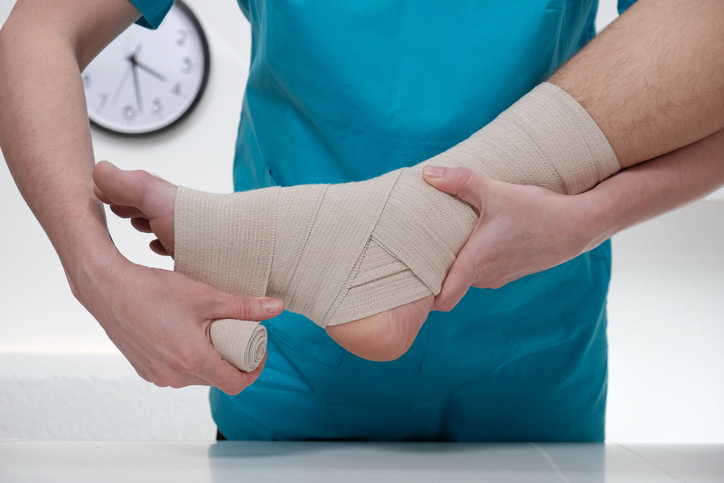Musculoskeletal Disorders: Sprains & Strains While Working

Sprains and strains are common injuries in the workplace. They can impact anyone, not just people who perform manual labor.
Unfortunately, the workers’ compensation system can be tricky for someone who suffered a musculoskeletal disorder like a sprain or strain while working. A Shook & Stone attorney could help you obtain the benefits you are due.
Understanding Sprains and Strains
Both sprains and strains are soft tissue injuries, meaning they affect the tendons, ligaments, and muscles. They are harder to identify on standard imaging tests than injuries to bones. Doctors usually diagnose a strain or sprain by taking a thorough medical history and reviewing the patient’s self-reported symptoms.
A strain is an overstretched or torn muscle or tendon, which is the connective tissue connecting the muscle to a bone. An injury to a ligament or joint capsule is a sprain. Ligaments connect bones to other bones, and a joint capsule is a protective fibrous layer with an inner membrane. The fibrous layer covers a joint and the membrane produces fluid to lubricate it.
Sprains and strains can be acute, meaning they result from a discrete event like turning your ankle or lifting something heavy. Strains can also be chronic. For example, someone might experience a mild strain and then continue to stress the affected body part, leading to lingering pain and lost strength and range of motion. Jobs that require repetitive motion could cause a chronic strain.
Sprain and Strain Risk Factors
Obesity, poor physical condition, and age can be risk factors for sprains and strains. However, extremely fit people also suffer this injury. Sprains and strains frequently affect high caliber athletes.
Ill-fitting footwear or shoes that are inappropriate for the task can lead to knee and ankle sprains and strains of the muscles in the legs and lower back. Improper lifting techniques can cause back strains.
Treatment Options
When a sprain or strain is mild, doctors typically recommend rest and analgesics for pain. When a sprain or strain is more serious, immobilization of the affected body part might be necessary to allow healing. Surgery is sometimes required to repair a torn muscle, tendon, or ligament.
Many Workplace Activities Could Cause a Strain or Sprain
Reaching, lifting, and pulling often cause sprains and strains to the back and upper body. Laborers, nursing home workers, stock clerks, shipping personnel, delivery drivers, and many other workers sustain injuries in this manner.
Repetitive motion and overexertion can cause strains. People who work all day at a computer, restaurant and food service workers, musicians, and others can develop chronic or acute muscle strains.
When you suffer a strain or sprain at work, Nevada Revised Statute § 616C.010 requires you to report the injury to your supervisor or HR as quickly as possible. If you wait too long, the employer could deny your claim for worker’s compensation benefits. If your injury is not acute but developed over time, report it as soon as you receive a diagnosis. Our Shook & Stone attorneys can walk you through the steps of filing an initial claim and help you if your employer denies the claim.
Sprains, Strains, and the Workers’ Compensation Program
When you get hurt at work, the workers’ compensation program covers your medical care and a partial wage if you must take time off. Depending on your job, a sprain or strain could temporarily or even permanently prevent you from working. For example, if you are a restaurant server and suffered a moderate or severe ankle sprain, you could be off work for several weeks. If you are a landscaper and suffer from chronic lower back muscle strain, you may need to find employment in another industry.
You must receive treatment for your work-related injury from an approved healthcare professional who is on the Workers’ Compensation Panel of Treating Physicians and Chiropractors. The provider will examine you regularly as you recover and may recommend you return to work on light duty or full-time. If you disagree with the provider’s recommendation, contact Shook & Stone. Our seasoned attorneys could help you dispute the doctor’s recommendation.
When your injury is significant, at some point you could reach a state of maximum medical improvement (MMI). Your treatment provider will assess your condition and issue a disability rating, which entitles you to disability payments and other benefits. Retraining is often available for workers who are fit to work but cannot withstand the physical demands of their former position.
Contact an Attorney After a Workplace Injury
Obtaining your benefits through the workers’ compensation system can be challenging when you have a soft tissue injury. Many variables affect how quickly you recover from a strain or sprain, and sometimes doctors think you should return to work before you are ready.
The lawyers at Shook & Stone have experience handling workers’ comp claims involving musculoskeletal disorders, sprains, and strains while working. Reach out today to schedule a free consultation with one of our knowledgeable attorneys.





